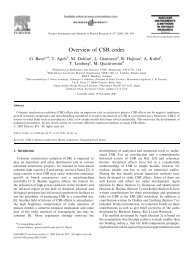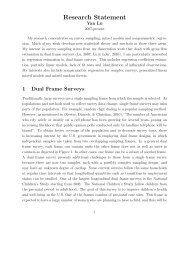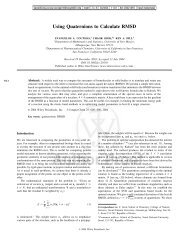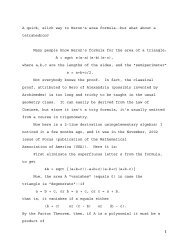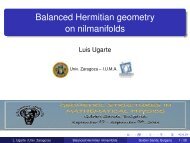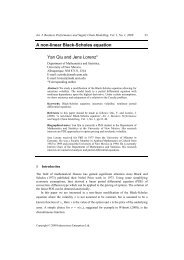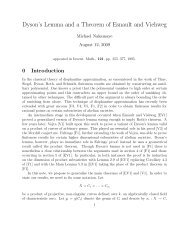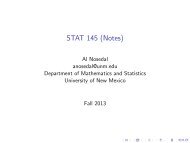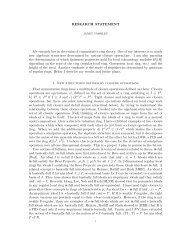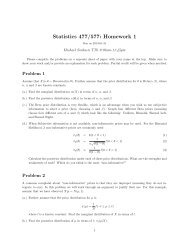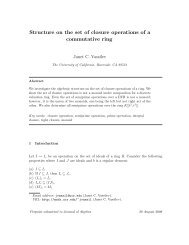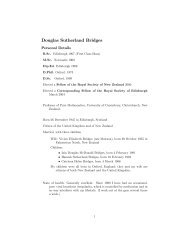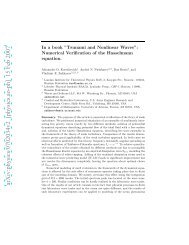OEO Office of Equal Opportunity - Department of Mathematics and ...
OEO Office of Equal Opportunity - Department of Mathematics and ...
OEO Office of Equal Opportunity - Department of Mathematics and ...
Create successful ePaper yourself
Turn your PDF publications into a flip-book with our unique Google optimized e-Paper software.
206 ARTS AND SCIENCES<br />
301. Advanced Japanese I. [Advanced Japanese.] (3)<br />
Continues development <strong>of</strong> four language skills (speaking, listening,<br />
reading <strong>and</strong> writing) at fifth semester level, introducing<br />
more complex grammar <strong>and</strong> spoken <strong>and</strong> written communicative<br />
tasks. {Fall}<br />
302. Advanced Japanese I. [Advanced Japanese.] (3)<br />
Continuation <strong>of</strong> 301. {Spring}<br />
320. Japanese Culture. (3 to a maximum <strong>of</strong> 6) ∆<br />
This course provides a multidisciplinary introduction to<br />
Japanese culture, with an emphasis on the anthropology <strong>and</strong><br />
sociology <strong>of</strong> contemporary Japan.<br />
339. Topics in Japanese Literature <strong>and</strong> Culture<br />
in Translation. [Japanese Literature <strong>and</strong> Culture in<br />
Translation.] (3, no limit) ∆<br />
(Also <strong>of</strong>fered as COMP, ENGL 339.) Study <strong>of</strong> individual<br />
authors, genres <strong>and</strong>/or periods <strong>of</strong> Japanese literature <strong>and</strong><br />
culture in translation.<br />
*411. Topics in Japanese Culture. (3, no limit) ∆<br />
Explorations <strong>of</strong> a variety <strong>of</strong> topics in Japanese language,<br />
literature, arts <strong>and</strong> social sciences.<br />
497. Undergraduate Problems. (1-6 to a maximum <strong>of</strong> 6) ∆<br />
Restriction: permission <strong>of</strong> instructor.<br />
Languages<br />
Warren Smith, Advisor, Ortega Hall 353B, (505) 277-3708,<br />
wsmith@unm.edu.<br />
This interdisciplinary major <strong>of</strong>fered through the <strong>Department</strong><br />
<strong>of</strong> Foreign Languages <strong>and</strong> Literatures in conjunction with the<br />
<strong>Department</strong> <strong>of</strong> Spanish <strong>and</strong> Portuguese can be taken through<br />
one <strong>of</strong> two options.<br />
Option A requires 42 credit hours <strong>of</strong> course work; students<br />
electing to take Option A do not need a minor or a second<br />
major. Option B requires 24 credit hours <strong>of</strong> course work;<br />
students electing to take Option B need a minor or a second<br />
major.<br />
Option A<br />
Requirements: 42 hours <strong>of</strong> course work, to be distributed<br />
as follows:<br />
1. Latin or Greek 101 (3 hours)<br />
2. Linguistics 101 or 292 (3 hours)<br />
3. Nine hours <strong>of</strong> course work above 300 in each <strong>of</strong> two <strong>of</strong><br />
the following languages (18 hours):<br />
French, German, Italian, Portuguese, Russian (200 or<br />
above) <strong>and</strong> Spanish<br />
4. Six hours <strong>of</strong> lower division course work in a language<br />
other than the two counted under category 3 above<br />
(including Chinese, Latin, Greek, Japanese, Navajo,<br />
Signed Language or Swahili) (6 hours)<br />
5. Twelve additional hours <strong>of</strong> course work either in<br />
Linguistics, the languages chosen under categories<br />
1 or 3 (upper division only), or 4 (lower division possible),<br />
or English courses such as History <strong>of</strong> the English<br />
Language, Old English, or Comparative Literature 223<br />
or 380 (but not both) (12 hours)<br />
Option B<br />
A minor or a second major is necessary for Option B.<br />
Requirements: 24 hours <strong>of</strong> course work, to be distributed<br />
as follows:<br />
1. LATN or GREK 101 (3 hours)<br />
2. Linguistics 101 or 292 (3 hours)<br />
3. Nine hours <strong>of</strong> course work above 300 in each <strong>of</strong> two<br />
<strong>of</strong> the following languages: French, German, Greek,<br />
Italian, Latin, Portuguese, Russian (200 or above) <strong>and</strong><br />
Spanish. Comparative Literature 223 or 380 may also<br />
be counted toward category 3 (18 hours)<br />
Minor Study Requirements<br />
Nine hours <strong>of</strong> courses above 300 in each <strong>of</strong> two languages<br />
(18 hours).<br />
Latin (LATN)<br />
Joseph McAlhany, Advisor, Ortega Hall 347B, 277-1181<br />
jcm3@unm.edu<br />
Warren Smith, Ortega Hall 353B, 277-3708<br />
wsmith@unm.edu<br />
Major Study Requirements<br />
See Classical Studies.<br />
Minor Study Requirements<br />
Twelve hours in courses numbered above 200.<br />
Placement—Elementary <strong>and</strong> Intermediate<br />
Courses<br />
Students who have previously studied Latin should determine<br />
their entry level at the University <strong>of</strong> New Mexico by consulting<br />
with the advisor for Latin.<br />
101. Elementary Latin I. [Elementary Latin.] (3)<br />
Introduction to the Latin language; grammar, syntax <strong>and</strong><br />
readings in Roman authors. {Fall, Spring}<br />
102. Elementary Latin II. [Elementary Latin.] (3)<br />
Continuation <strong>of</strong> 101. Introduction to the Latin language; grammar,<br />
syntax <strong>and</strong> readings in Roman authors. {Spring}<br />
103. Latin Lab Session. (1)<br />
To be <strong>of</strong>fered every term concurrently with 101 as a lab or<br />
practice session for the beginning student; only for those wishing<br />
an extra 1 hour credit. Offered on a CR/NC basis only.<br />
105. Vocabulary Building. (3)<br />
To assist the students in improving their vocabulary <strong>and</strong><br />
knowledge <strong>of</strong> English through a study <strong>of</strong> the derivation <strong>of</strong><br />
English from Greek <strong>and</strong> Latin roots.<br />
201–202. Intermediate Latin I–Intermediate Latin II.<br />
[Intermediate Latin.] (3, 3)<br />
Systematic review <strong>of</strong> Latin grammar <strong>and</strong> syntax; readings in<br />
simple prose authors such as Cicero <strong>and</strong> Caesar; introduction<br />
to Latin poetry <strong>and</strong> scansion.<br />
*303. Advanced Latin I. [Readings in Latin Literature.] (3,<br />
3, no limit) ††<br />
Readings in Classical authors such as Plautus, Catullus,<br />
Vergil, Horace <strong>and</strong> Ovid. Occasional composition in Latin.<br />
*304. Advanced Latin II. [Readings in Latin Literature.]<br />
(3, 3, no limit) ††<br />
Readings in Classical authors such as Plautus, Catullus,<br />
Vergil, Horace <strong>and</strong> Ovid. Occasional composition in Latin.<br />
*351. Accelerated Latin I. [Accelerated Latin.] (3)<br />
Essentials <strong>of</strong> basic Latin grammar, morphology <strong>and</strong> vocabulary,<br />
with emphasis on etymology <strong>and</strong> a comparative study <strong>of</strong><br />
Latin <strong>and</strong> its relationship to the Modern Romance Languages<br />
<strong>and</strong> English.<br />
*352. Accelerated Latin II. [Accelerated Latin–Reading.]<br />
(3)<br />
The evolution from Classical Latin to Medieval Vulgar Latin<br />
<strong>and</strong> its relationship to the Modern Romance Languages<br />
<strong>and</strong> English; the reading <strong>of</strong> selected Classical <strong>and</strong> Medieval<br />
texts.<br />
UNM CATALOG 2006–2007 Symbols, page 611.



